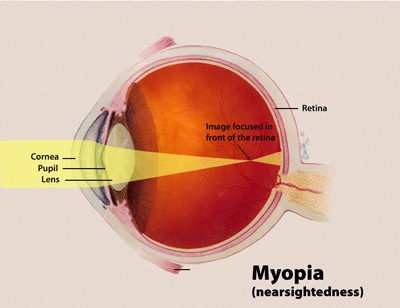Myopia 23, Autosomal Recessive

A number sign (#) is used with this entry because of evidence that myopia-23 (MYP23) is caused by homozygous mutation in the LRPAP1 gene (104225) on chromosome 4p16.
DescriptionMyopia, or nearsightedness, is a refractive error of the eye. Light rays from a distant object are focused in front of the retina and those from a near object are focused in the retina; therefore distant objects are blurry and near objects are clear (summary by Kaiser et al., 2004).
For a discussion of genetic heterogeneity of myopia, see 160700.
Molecular GeneticsIn 3 consanguineous Saudi Arabian families in which multiple sibs, aged 2 to 16 years, had nonsyndromic extreme myopia with spherical equivalents of -17 diopters or greater and subnormal best-corrected visual acuity, Aldahmesh et al. (2013) performed autozygome analysis and identified only 1 interval exclusively shared among all 8 affected individuals. Linkage analysis confirmed the autozygous interval, and exome sequencing revealed 2 homozygous truncating mutations in the LRPAP1 gene: a 1-bp deletion in 1 family (104225.0001) and a 2-bp deletion in the other 2 families (104225.0002). The mutations, which segregated fully with myopia in each family, were not found in 210 Saudi exome files or in the SNP databases of the 1000 Genomes Project or Exome Variant Server. Analysis of the LRPAP1 gene in 100 individuals with myopia of -6 diopters or greater did not reveal any evidence of an increased load of rare variants compared to 100 similarly screened controls.
In a 5-year-old Chinese boy (HM759), born to consanguineous parents, with bilateral high myopia, Jiang et al. (2015) identified homozygosity for a frameshift mutation in the LRPAP1 gene (104225.0003). The parents were unaffected, but their DNA was not available for testing. Functional studies were not performed.